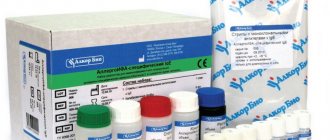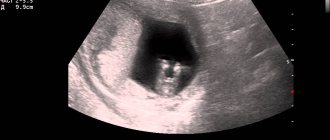Pregnant women are prescribed frequent tests of all kinds to find out whether the fetus is developing correctly and what possible threats may interfere with its healthy growth.
One of the important and necessary ones is a detailed coagulogram: what is it and what abnormalities does it show during pregnancy?
What it is?
The coagulogram has a second name - hemostasiogram. This is a blood test that allows you to determine at what speed, how quickly the blood clots and the processes of hemostasis occur. This analysis is mandatory and is done three times during pregnancy. The first time it is done during registration in order to assess the prognosis of complications during pregnancy.
The coagulogram is repeated in the second trimester, at approximately 22-24 weeks. A hemostasiogram is necessarily prescribed shortly before childbirth or a planned cesarean section, so that doctors can at least approximately predict blood loss, prepare more thoroughly and, if necessary, involve hematologists in the delivery.
The essence of hemostasis comes down to the fact that when blood vessels are damaged under the influence of special plasma proteins - enzymes - the process of creating a blood clot is started, which tightly closes the site of a possible “leak”. After restoration of the integrity of the endothelium, the need for a blood clot disappears; the vessel needs to get rid of it. Hemostasis at this stage ensures the dissolution of the blood clot and cleansing of the vessel.
This is how these processes look normal, but sometimes disturbances occur in the fragile hemostatic system, and an analysis such as a coagulogram can tell a lot about them.
All the nuances of the coagulation and anticoagulation systems and mechanisms are shown by the study, which is considered one of the most “labor-intensive” and complex in laboratory practice. It requires great precision from the laboratory assistant and does not tolerate connivance and inattention.
A person’s life depends on the results and their correct interpretation, and in the case of pregnant women, two lives at once.
A bleeding disorder can cause big problems. Thus, liquid blood (this is what people call poor coagulation, its insufficiency) can cause placental abruption and bleeding both during pregnancy and childbirth. This is also dangerous in the postpartum period. Thick blood (meaning an increase in hemostasis) can lead to the formation of blood clots, which often causes fetal hypoxia.
Blood clots are one of the most common causes of maternal mortality - death occurs in a matter of minutes due to pulmonary embolism. A bleeding disorder is also dangerous due to the risk of premature birth or miscarriage.
What is hemostasis
Hemostasis is a blood clotting system that protects against excessive blood loss. For example, you cut your finger. At first the blood flows heavily from the finger, then gradually slows down. This is how the hemostasis system works - at the site of damaged tissue, the blood coagulates and stops.
During pregnancy, the blood coagulation system is activated. This is a physiological process necessary for the normal course of labor. When a child is born, placental abruption occurs, the birth canal is often damaged, and bleeding occurs. Under normal circumstances, this would lead to profuse blood loss. But the hemostatic system is ready for childbirth - and the woman loses only 200-400 ml of blood. Such blood loss is considered physiological and does not pose a danger to the woman in labor.
Activation of the hemostatic system does not always go smoothly. For reasons that are not completely clear, blood clotting is sometimes excessive. Thrombosis processes intensify, and serious complications arise. Blood clots form in the vessels of the uterus and placenta, preventing the transfer of oxygen and nutrients to the fetus and interfering with its development. Termination of pregnancy and fetal death are possible.
To prevent the development of complications, the hemostatic system must be monitored. For this purpose, a blood test is prescribed - hemostasiogram. When assessing its indicators, the doctor can see deviations and take the necessary measures.
To whom is it assigned?
As already mentioned, all pregnant women are required to donate blood for a coagulogram three times during pregnancy. However, there are categories of expectant mothers who will have to take this test much more often. These include women with the following complications:
- Rhesus conflict pregnancy;
- woman's tendency to varicose veins;
- various liver diseases in the expectant mother;
- diseases of the cardiovascular system;
- history of several miscarriages, recurrent miscarriage;
- pathologies of the placenta;
- multiple pregnancy (twins, triplets);
- identified disorders of blood clotting factors.
In all these cases, a coagulogram is carried out according to the basic scheme. There is also an extended analysis - a detailed hemostasiogram, it is carried out for special indications for women who suffer from high blood pressure, gestosis with edema in both the first and third trimesters.
A pregnant woman will be prescribed an extended analysis even if she is carrying twins or triplets, and also has a predisposition to blood and vascular diseases.
What is a coagulogram?
A coagulogram (clotting test) is a common blood test that helps examine its ability to clot: whether there are any disorders in the form of increased or decreased coagulation.
It is done without fail, since with its help the hemostasis system is examined, and the tendency of the expectant mother’s body to blood clots and bleeding, which affects the pathological development of the child, difficult or premature births, miscarriages, and other disorders, is also determined. Providing the results of the hemostatic system in graphical form is also called a hemostasiogram.
When analyzing a coagulogram, the main and additional indicators of coagulation are checked (presented in the table below).
Coagulogram
| Kinds | Indicators |
| 1. Main | 1. Fibrinogen |
| 2. Prothrombin, including INO | |
| 3. APTT | |
| 4. Thrombin time | |
| 2. Advanced | Basic indicators |
| + additional | |
| 5. Antithrombin III (AT3) index | |
| 6. D-dimer | |
| 7. Lupus anticoagulant |
Violations when an extended coagulogram is prescribed
- Varicose veins,
- Multiple pregnancy
- miscarriage,
- Liver pathology,
- Intrauterine fetal death last time,
- Cardiovascular system disorders,
- Genetic blood pathology,
- Condition after surgery,
- Complex form of toxicosis,
- Bad habits in pregnant women
- Pathologies of the urinary and endocrine systems,
- Preeclampsia and placental insufficiency.
How to get tested?
Preparing for a coagulogram involves following a diet. For a couple of days, it is not advisable to eat spicy, salty, or fatty foods. 10-12 hours before donating blood, it is not recommended to eat at all; you are only allowed to drink clean, still water. The day before the analysis, you should avoid coffee, strong tea, fruit drinks, compotes and any carbonated drinks. You should not drink too much fluid, as this may lower your readings.
Also, to prepare for the study, you should protect yourself from stress and emotional outbursts. It has long been proven that the nervous factor has a significant impact on the results of a coagulogram.
Blood is taken from a vein in the morning. The analysis time is approximately 1 day. Depending on the workload of the laboratory, the maximum analysis time is 2 days.
The need and frequency of testing for coagulation during pregnancy
For pregnant women, a coagulogram is an extremely important analysis. With its help, the balance of the coagulation and anticoagulation systems is monitored.
- The absence of such a balance carries, as mentioned above, consequences that threaten the health of the expectant mother and fetus.
- An imbalance towards the anticoagulation system can cause metrorrhagia, placental abruption, blood loss during and after childbirth in a woman in labor, and towards the coagulation system it thickens the blood, forming blood clots. In this case, a child who receives oxygen exclusively from the placenta experiences oxygen starvation, hypoxia develops, brain pathologies may develop, the woman suffers from leg pain and the development of blood clots, and this can also cause a heart attack, stroke or miscarriage.
The test procedure is as follows: before taking blood, it is better to fast, that is, take the test on an empty stomach. Blood is taken from a vein on the bend of the elbow, and the result of the hemostasiogram is deciphered by your attending physician.
If the indicators are normal, the diagnosis is carried out three times as planned:
- During the registration of a pregnant woman (usually the 1st trimester),
- In the second trimester,
- A week or two before giving birth, which is especially important for women who are preparing to give birth by cesarean section.
In case of complications or abnormal pregnancy, homeostasis is checked much more often in order to respond adequately and prescribe effective treatment.
The normal indicators for a woman during this period, due to changes in physiology, are somewhat different from the indicators before conception, since the female body sets up another blood circulation through the utero-placental-fetal blood flow (insuring itself from significant blood loss). Therefore, only your registered doctor can diagnose the coagulogram results.
Decoding
The analysis describes several key key indicators that affect blood clotting factors in pregnant women.
- APTT. This abbreviation is an abbreviation for activated partial thromboplastin time - the period of time required for the formation of a blood clot. In women expecting a child, the aPTT is always slightly reduced compared to non-pregnant women and men. If the aPTT is increased relative to normal, this indicates that the blood is clotting slowly and there is a possibility of bleeding. If the aPTT is reduced relative to normal, they speak of “thick” blood and the associated likelihood of blood clots.
- Fibrinogen. This is a protein that is produced by the liver. It is necessary for the formation of a blood clot, since when exposed to certain enzymes it creates the very fibrin threads that tighten the wound site. Without fibrinogen, the formation of blood clots would be impossible. In all pregnant women, with increasing gestational age, a physiological increase in fibrinogen concentration is observed. This is how the pregnant woman’s body prepares for the upcoming birth.
- TV. Behind this reduction lies the time required for clotting, thrombin time. In pregnant women, even completely healthy ones, the period of thrombus formation may increase, especially in the first half of pregnancy. This indicator is often abnormal compared to the norm in women suffering from liver diseases.
- VA . This indicator stands for lupus anticoagulant. This refers to an indicator that evaluates the formation of antibodies. The norm is the complete absence of lupus anticoagulant in the blood of the expectant mother. If VA is still present, this may indicate the presence of an autoimmune disease, gestosis, or thrombosis.
- CT. This is the platelet count. It is these blood platelets that take the most active and active part in the process of blood clotting. A high platelet count always indicates a clotting disorder, as does a decrease in the concentration of these cells in the blood.
- D-dimer . This is a protein substance that is formed as a result of the breakdown of blood clots and cleaning of the vessel - fibrinolysis. By the amount of residual substance, one can judge how balanced the second part of hemostasis is - the dissolution and removal of blood clots. In all pregnant women, D-dimer is slightly elevated, but a significant increase in its concentration in the blood of the expectant mother is a very alarming phenomenon, characteristic of diabetes mellitus, gestosis, and kidney diseases.
- Prothrombin. This is a plasma protein that directly affects the process of blood clotting. The determination of prothrombin is considered the most important indicator of a coagulogram. In the last trimester of pregnancy, the concentration of prothrombin may decrease slightly.
- RFMK . This refers to soluble fibrin-monomer complexes, intermediate products of clot breakdown as a result of its dissolution (fibrinolysis). If the indicator increases, a tendency to thrombosis, recent injuries associated with blood loss, and operations are suspected. RFMK also increases with gestosis, preeclampsia, and renal failure.
- AT-3. This is the designation for another protein – antithrombin-3. Its task is to make the coagulation process slower and prevent rapid coagulation. It acts as a regulator. As with most other indicators, the excess or decrease in the level of AT-3 relative to the norm is assessed. An increase indicates a risk of thrombosis, and a decrease indicates that the expectant mother has too “thin” blood.
Interpretation of results
The indicators of the hemostasis system are assessed by a hemostasiologist taking into account the duration of pregnancy. Each parameter is responsible for its own link in the blood coagulation system.
APTT
Activated partial thromboplastin time (aPTT) is the period during which a blood clot forms. It shows how quickly this process occurs. Before the baby is conceived, the aPTT is 25-35 seconds. During pregnancy, the indicator gradually decreases and reaches 18-22 seconds at 32-36 weeks. If the aPTT drops below 16 seconds, the risk of blood clots increases.
A decrease in aPTT is associated with physiological processes occurring during pregnancy:
- the emergence of a new circle of blood circulation;
- increase in circulating blood volume;
- increased blood clotting closer to the time of birth.
Sometimes a decrease in APTT is associated with other processes occurring in the body of the expectant mother:
- infectious diseases;
- inflammatory processes, including chronic ones;
- malignant neoplasms.
A high APTT is also unfavorable for a pregnant woman. This means that the hemostatic system has not adapted to the new conditions. During childbirth, the risk of heavy blood loss increases.
APTT increases in the following conditions:
- hereditary diseases of the blood coagulation system;
- liver pathology, in which the synthesis of coagulation factors is disrupted;
- vitamin K deficiency;
- antiphospholipid syndrome;
- severe kidney pathology;
- transferred blood transfusions.
Prothrombin test
The prothrombin test is an indicator of the extrinsic (fast) pathway of blood clotting. Vitamin K dependent factors are involved. In a hemostasiogram it is expressed by two indicators:
- Kwik activity. It increases with thrombophilia and indicates the risk of developing thrombosis. Decreases in some hereditary diseases of the blood coagulation system, vitamin K deficiency.
- INR (International Normalized Ratio). Introduced into practice to standardize the results of prothrombin time.
Thrombin time
Thrombin time is the period during which fibrinogen is converted into fibrin. It increases with the development of thrombophilia and a high risk of thrombosis. Decreased in some autoimmune diseases and kidney diseases.
The norm is 11-18 seconds. During pregnancy, it lengthens slightly in later stages.
Fibrinogen
Fibrinogen (factor I) is a blood plasma protein that is converted into fibrin. In the first trimester it remains within the range of 2-4.5 g/l (as before pregnancy). With the growth of the fetus it increases and reaches 4-6.5 g/l by birth.
An increase in fibrinogen indicates a high risk of thrombosis and is associated with the following conditions:
- cardiovascular pathology;
- infectious and inflammatory processes;
- autoimmune pathology;
- neoplasms of various localizations;
- hypothyroidism;
- amyloidosis;
- condition after surgery;
- injuries.
Low fibrinogen occurs in the following situations:
- genetic defect of the hemostatic system;
- severe gestosis and eclampsia;
- HELLP syndrome;
- acute fatty liver degeneration;
- severe toxicosis;
- blood loss
RFMK
Soluble fibrin-monomer complexes are the basis of the thrombus. Before pregnancy, the RFMC level remains within 4 mg/100 ml. After conceiving a child, the rate increases to 5-7 mg/100 ml. Exceeding this limit indicates the following conditions:
- hereditary defect of the hemostatic system;
- conditions in which the risk of thrombosis increases: heart and vascular diseases, autoimmune processes, diabetes mellitus;
- purulent inflammatory diseases;
- gestosis;
- previous injuries and surgeries.
A decrease in RFMC is usually associated with an overdose of drugs that affect blood clotting.
D-dimer
D-dimer is a protein fragment of a blood clot. It is not included in the structure of a regular hemostasiogram and is prescribed only in the presence of risk factors for thrombosis. Before conceiving a child and in the first trimester, D-dimer remains low - 0-55 mcg/ml. Further, the protein level gradually increases and reaches 0.4-3 μg/ml by the end of pregnancy.
Increased D-dimer is associated with the following conditions:
- hereditary pathology of hemostasis;
- hypercoagulability syndrome;
- gestosis;
- severe toxicosis in early pregnancy;
- severe infectious diseases;
- cardiovascular pathology;
- liver diseases;
- condition after surgery or injury.
The decrease in D-dimer is not clinically significant.
Other indicators
The hemostasiogram of a pregnant woman takes into account:
- Antithrombin III – 70-115%. A sharp decrease in this indicator during pregnancy indicates a high risk of thrombosis. Antithrombin III deficiency is more common in women over 35 years of age.
- Platelets – 150-400x109/l. The more platelets, the faster blood clots form.
- Lupus anticoagulant. Normally it shouldn't be there. Occurs in antiphospholipid syndrome and indicates pathology of the hemostatic system.
- Protein C. During pregnancy, its level decreases slightly. With a deficiency of this indicator, the risk of developing thrombosis increases.
- Thrombin time. Determined if APTT and prothrombin time are changed. An increase in this indicator is observed in autoimmune processes, against the background of irrational heparin therapy.
- Fibrinolytic activity is the rate of dissolution of a blood clot. Shortens with a decrease in fibrinogen. It is lengthened in case of congenital disorders of the hemostasis system, pathology of the liver and kidneys, and infectious processes.
Why take this test during pregnancy?
The condition of the circulatory system is an important indicator of the health of a pregnant woman. Deviations from the norm may indicate the development of serious complications. Coagulogram is an analysis that shows the level of blood clotting (hemostasis) in the body . In medicine it is also called “hemostasiogram”. This is a rather complex study that allows us to determine the functioning of the coagulation and anticoagulation systems.
Pregnancy involves many changes physically and psycho-emotionally. The work of a woman’s circulatory system is no exception. At this time, hemostasis indicators increase. Thus, the female body is gradually preparing for the appearance of an additional circle of blood circulation and for the inevitable blood loss during childbirth.
For the expectant mother and baby, any changes in the coagulorogram may mean the development of pathology. With a reduced level of hemostasis, severe blood loss and placental abruption are possible. If the indicator is elevated, there is a threat of thrombus (blood clot) formation, which will inevitably lead to fetal hypoxia. In addition, the tendency to form blood clots can threaten blockage of the pulmonary artery vessels. Thrombosis of the veins of the lower extremities and pelvic veins is also possible.
Important! If not properly monitored and treated, bleeding disorders can lead to premature birth or miscarriage.
Video: why blood clotting indicators are important
conclusions
A hemostasiogram is of great importance, both for the life and health of a pregnant woman and her unborn child. And if the coagulogram is normal, then there is nothing to worry about, therefore there is no danger to the health of the mother and fetus. But if the indicators are outside the normal range, then you need to contact your doctor for advice as soon as possible.
The main thing is not to panic, but to undergo all the examinations that your doctor prescribes, so that, if necessary, you can adjust the treatment to obtain good results.
Every pregnant woman undergoes a series of tests. Some of them are mandatory, while others are required for certain indications. Blood tests allow you to evaluate the functioning of the female body and promptly identify possible complications during pregnancy. The list of necessary items also includes a clotting test - a coagulogram.
In what cases is a clotting test indicated?
A planned analysis is carried out three times throughout the pregnancy:
- When registering with a gynecologist.
- At 22–24 weeks (II trimester).
- At 30–36 weeks (III trimester, shortly before birth).
It should be noted that a coagulogram is performed once per trimester only during normal pregnancy . In some cases, additional research is recommended. This happens when a woman is diagnosed or suspected of:
- autoimmune diseases;
- phlebeurysm;
- liver diseases;
- Rh conflict with the child’s father;
- vascular, endocrine pathologies;
- disorders of the circulatory system,
- disorders of the genitourinary system;
- predisposition to bleeding or increased clotting;
- miscarriage of a previous pregnancy;
- multiple pregnancy;
- disorders of the placenta;
- anemia or iron deficiency anemia (more details: https://krasnayakrov.ru/organizm-cheloveka/zhelezodeficitnaya-anemiya.html);
- tendency to thromboembolism, heart attack, stroke.
What kind of test is this for pregnant women?
A coagulogram is included in the list of laboratory tests when managing a pregnant woman.
Doctors use it to assess the condition of the pregnant woman, determine the presence of pathology and provide appropriate treatment. A study of the hemostatic system during pregnancy allows one to predict the course of pregnancy. Identify possible disturbances in the uteroplacental blood flow.
Based on the hemostasiogram indicators, it is possible to prevent the development of bleeding at the time of childbirth or in the postpartum period.
Nature intended that during pregnancy, the blood becomes thicker due to the main components (in particular fibrinogen).
Its thickening reduces the risk of bleeding during labor or the postpartum period. But for some reason, hemostasis is disrupted, the consistency changes, and a tendency to thrombus formation appears.
How to prepare for the procedure
Blood is drawn from a vein. It is not recommended to eat for 8–12 hours before the test. The analysis is taken only in the morning on an empty stomach. You should also not drink coffee, tea, compotes and other drinks. You are allowed to drink only regular still water .
Before the study, the woman needs to calm down, since it has been proven that tension and stress affect the result.
If a woman is taking any medications, she must inform the laboratory assistant about this in advance and write down the names of the medications on the analysis form..
Video: proper preparation for a blood test
Advantages and disadvantages of the study
Unlike other screening studies, analysis of a hemostasiogram during pregnancy allows for a more detailed assessment of the state of the hemostatic system. This procedure recognizes many pathological processes and abnormalities associated with blood clotting.
There is only one disadvantage of a hemostasiogram - small errors in the readings. The point is that each laboratory carries out analysis in its own way and uses its own diagnostic equipment. This does not mean that the results may be incorrect, but it is better to donate blood for testing in the same laboratory.
It is extremely important to know about the state of the coagulation system when treating various surgical, oncological and cardiovascular diseases in pregnant women. This analysis is of great importance in emergency situations, such as stroke, heart attack, or in preparation for operations.
Blood clotting is a kind of protective mechanism that prevents significant blood loss. This process, like most others in the human body, must be in balance. An imbalance towards hypercoagulation leads to the formation of blood clots. As already mentioned, in a critical condition, thrombosis poses a danger to the life and health of a pregnant woman. Blockage of vital arteries is fraught with disturbances in the blood supply to the heart, lungs and other organs.
A blood test for coagulation is very important not only in diagnosing problems of the hemostatic system, but also for assessing the effectiveness of therapy that is already being carried out. To select the optimal dose of medications, control the treatment process and prevent complications. Only laboratory diagnostics can make an accurate diagnosis and there is no need to be afraid of this; it is better to act, keeping your health under control.
Moreover, expectant mothers should know that the procedure for taking venous blood is practically painless, and the drugs used to treat and normalize the functioning of coagulation systems are absolutely harmless. Having a hemostasiogram during pregnancy significantly increases the chance of carrying a healthy baby and avoiding heavy blood loss during childbirth.
Decoding of indicators and norm
The clotting test contains eight leading indicators:
- Fibrinogen is a protein produced by the liver. It is the main element of thrombus formation. Thanks to the uteroplacental circulation, its levels gradually increase as the day of birth approaches. Deviation from the norm indicates an inflammatory process taking place in a woman’s body.
- Activated partial thromboplastin time (aPTT) is the period during which one blood clot forms. In pregnant women, this value decreases slightly, which is normal. A large decrease in level indicates a risk of blood clots, while an increase indicates a predisposition to bleeding.
- Thrombin time (TV) is the period of blood clotting. During pregnancy it increases. Deviation from the norm often occurs when there is a malfunction of the liver.
- Lupus anticoagulant is an indicator of antibody formation. Normally, they should not be found in the blood of a pregnant woman. Their appearance, as a rule, indicates autoimmune diseases, gestosis, and the presence of blood clots in the arteries and veins.
- Platelets are blood cells that take an active part in the coagulation process and are responsible for the state of the hematopoietic system. During pregnancy, their level decreases slightly, and a significant decrease indicates the presence of a progressive disease.
- D-dimer is an indicator of thrombus formation procedure. During pregnancy it increases slightly. A sharp increase indicates the development of diabetes, kidney disease or gestosis.
- Antithrombin III is a protein that slows down the process of blood clotting. A decrease in its amount means a tendency to form blood clots, and an increase in its level means an increased risk of bleeding.
- Prothrombin is a component of blood plasma. An increase in level may indicate placental abruption.
In a normal pregnancy, four coagulogram indicators are usually sufficient:
If necessary, a detailed picture of blood clotting is done. Even a slight deviation from the norm can lead to serious consequences.
Interpretation of the results of a coagulogram is carried out only by a doctor, since there are errors in the indicators that may be associated with a woman’s chronic diseases, malnutrition, or taking medications.
Deciphering violations in the results and their causes
Below is a table of deviations from the norm in the coagulogram, which are dangerous during pregnancy and their possible causes.
| Index | Numerical value within normal limits | Possible deviation | Causes |
| APTT | 15-20 seconds | increase to 25-39 sec. reduction to 10-12 sec. | vitamin K deficiency, von Willebrand disease, liver disease. DIC syndrome, inflammatory processes. |
| Fibrinogen | 6 g/l | Increase over 6 g/l | Infectious diseases, necrotic processes, burns and injuries, lupus, heart attack, tumor |
| D-dimer | 250 ng/ml | Increase more than 4.5 times | Preeclampsia, kidney disease, internal hematomas and hemorrhages |
| Platelet level | 150-350 * 1099 per 1 l. blood | increase; decrease. | diarrhea, toxicosis, frequent vomiting, thromboembolism, dehydration, chronic bleeding, poor nutrition, disorders of the immune system. |
In cases of serious changes in data, if there is a threat to the life of the mother or fetus, inpatient treatment is often prescribed or the pregnancy is terminated altogether.
Hemostasis during pregnancy norm table
The blood coagulation system, which is responsible for its consistency and ability to clot, is represented by several components. It performs the following functions important for the normal functioning of the entire body:
- quickly responds to capillary damage and forms blood clots to stop bleeding;
- provides sufficient viscosity and fluidity of blood in the vessels.
Blood clotting is ensured by formed elements, vessel walls and plasma proteins. Several systems are involved in plasma hemostasis: coagulation and anticoagulation, destruction of blood clots. In order for a blood clot to form in a vessel, a special protein substance must first form, which forms its basis. If this complex mechanism of hemostasis is disrupted, the following consequences arise:
- increased coagulability, leading to thrombosis;
- decreased blood clotting with hemorrhagic syndrome and poorly resolved bleeding.
To prevent the development of such complications in women, a hemostasiogram is prescribed during pregnancy. This study reflects the picture of the blood as a whole and is especially indicated during gestation, since against the backdrop of the development of the unborn baby and the hormonal transformations occurring in the mother’s body, changes in the coagulation system are observed quite often. Subsequently, due to such deviations in hemostasis, a woman may experience serious phenomena:
- blood clots in the vascular system of the placenta - this condition is dangerous for the life of the unborn baby;
- the risk of placental abruption and the development of bleeding after childbirth increases - these complications are dangerous both for the life of the fetus and for the health of the expectant mother.
Tactics after the examination
If the results of a hemostasiogram reveal abnormalities, you need to contact a hemostasiologist. Usually such conditions respond well to correction. Drugs that affect the blood coagulation system are prescribed: antiplatelet agents, anticoagulants. The course of therapy lasts from 10 days. The choice of drug depends on the state of the blood coagulation system, stage of pregnancy and concomitant diseases.
Changes in the hemostatic system usually lead to pregnancy complications. Placental insufficiency often develops, blood flow is disrupted, and the supply of nutrients to the fetus deteriorates. Drugs that affect blood clotting change the situation for the better. Timely diagnosis and rational therapy can prolong pregnancy and reduce the risk of complications.
Indications for prescribing a hemostasiogram during pregnancy
The generally accepted timing for performing a coagulogram is the following gestational dates:
- when registering a woman for pregnancy;
- at 5-6 months;
- at 8-9 months of pregnancy.
In some cases, another detailed hemostasiogram may be prescribed before the birth itself. Indications for this study before delivery may include varicose veins, immunological diseases or abnormalities in liver function.
If necessary, a hemostasiogram is prescribed at other times. Indications for the study may be the following conditions and diseases:
- pathology of the genitourinary, endocrine or cardiovascular systems;
- deviations in previous coagulograms;
- threat of premature termination of pregnancy and uterine hypertonicity;
- frequent bleeding from the nasal passages and gums;
- negative Rh factor in the expectant mother;
- smoking;
- kidney and liver diseases;
- reduced elasticity of venous vessels;
- autoimmune pathology;
- multiple pregnancy;
- conception through IVF;
- vitamin K deficiency;
- slowing of intrauterine development of the fetus;
- pregnancy after 40 years;
- edema syndrome;
- fetoplacental insufficiency.
Even before pregnancy, a hemostasiogram can be prescribed for repeated spontaneous abortions and difficulties with conception.
Deviations from the norm
If any coagulogram indicator (or a combination of them) in a pregnant woman differs from the norm, the doctor may suspect pathology.
Table: reasons for deviation of the coagulogram from the norm
| Index | Deviations from the norm | Possible reasons |
| Fibrinogen | Increase more than 6 g/l |
|
| Decrease of less than 2 g/l (much less common) |
| |
| APTT | Increase to 21 seconds or more |
|
| Descent less than 16 seconds |
| |
| Thrombin time | Increase over 25 seconds |
|
| Descent less than 10 seconds |
| |
| Prothrombin | Increase over 142% |
|
| Decrease less than 78% |
| |
| Platelets | Increase more than 400 thousand/µl |
|
| Decrease below 130 thousand/µl |
|
Possible consequences for the expectant mother and child
Many of these pathologies (manifest themselves by deviations in the coagulogram) are serious and, in the absence of timely treatment, pose a great danger to the health of the expectant mother and fetus:
- DIC syndrome. At the initial stage of the disease, when microclots form in the body, the pregnant woman may develop placental insufficiency (as a consequence of hypoxia in the fetus), edema, and the appearance of protein in the urine. In subsequent stages, blood at the slightest damage can flow in a viscous stream, as if from an open vein. Probably massive bleeding from the uterus or some other internal organ. Sometimes such situations end in death (30% of cases).
- Thrombophlebitis. Due to the appearance of a large number of blood clots, blockage of the blood vessels of the placenta is possible. As a result, the development of the fetus slows down, it may develop congenital diseases, or it may die altogether. In addition, there is a risk of placental abruption.
- Hemophilia. May have irreversible consequences. During a natural birth, the mother is at great risk of cerebral hemorrhage; death is also possible during a cesarean section due to uncontrolled bleeding.
- Systemic lupus erythematosus. Complications are possible for both the mother and the fetus. Pregnancy is difficult because the kidneys cannot cope with the load (renal failure may develop). Possible fetal death, premature birth, and even death of the woman.
- Chronic myeloid leukemia. With this malignant change in the blood, the pregnant woman develops anemia, the body becomes more susceptible to attacks by viruses and bacteria, and kidney failure is likely to develop. All this affects the development of the fetus (it develops various abnormalities, there is a deficiency in birth weight), and the risk of miscarriage and premature birth increases.
How to donate blood correctly: rules for preparing for the study
When issuing a referral for a hemostasiogram, the doctor must explain to the patient what it is and how to properly prepare for the upcoming study. Compliance with these rules is an important part of the analysis, since the reliability of the results depends on the accuracy of their observance.
When preparing for the study, it is recommended that a woman, 5–7 days before blood sampling, stop taking medications that thin the blood, for example, acetylsalicylic acid and other non-steroidal anti-inflammatory drugs, antiplatelet agents, anticoagulants, etc. Taking these drugs additionally thins the blood, so the results will be inaccurate . It is also unacceptable to consume alcoholic drinks that have the opposite effect before taking a hemastasiogram.
A woman should inform her doctor who prescribed the test about taking other medications at least 24 hours in advance. The day before the test, the last meal and drinks should take place 8–12 hours before blood collection. Until the morning you can drink only plain water. It is also advisable to exclude physical activity and stressful situations. On the day of the examination, you should avoid eating and drinking water.
Material for research is collected by puncture of the ulnar vein. Results are usually available the next day, but sometimes turnaround times may vary depending on the laboratory where the test is performed.
Nuances of preparing for analysis
A coagulogram requires a blood sample from a vein (usually in the crook of the arm). For the indicators to be most reliable, a woman must meet certain conditions:
- come to the treatment room strictly on an empty stomach, and your last meal should be at least 8 hours ago;
- drink only plain clean water in the morning;
- if a pregnant woman took medications within 24 hours before taking the material, she must inform the health worker about this (he will make a corresponding note);
- Half an hour before blood sampling, avoid physical activity; you should also not be nervous or smoke.
Video: how to prepare for a blood test (doctor's advice)
Hemostasiogram indicators during pregnancy
When conducting an analysis, the form, in addition to the results, displays the following factors of the coagulation system and their norms:
- Fibrinogen – no more than 6.5 g/l.
- Prothrombin (or prothrombin time, prothrombin according to Quick) – 78–142%.
- INR (international normalized ratio) – 0.85-1.15 units.
- Thrombin time is 18–25 seconds.
- Activated partial thromboplastin time (aPTT) is 17–20 seconds.
If a detailed hemostasiogram is performed, the following values may be indicated:
- Platelets.
- Lupus coagulant.
- Antithrombin 3.
- D-dimer.
Such a detailed analysis is prescribed for certain indications. Reference values are indicated in the form.











